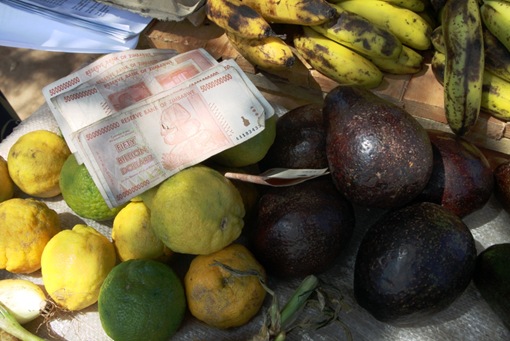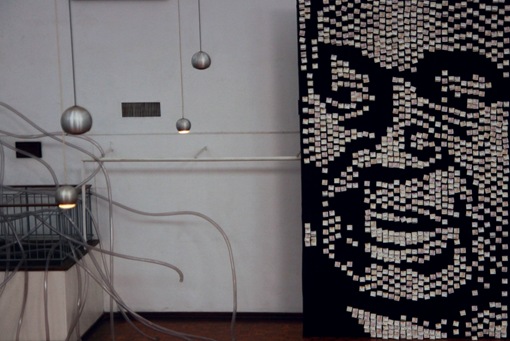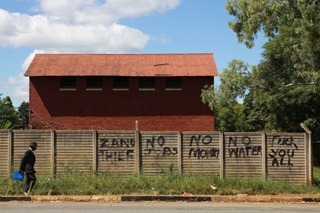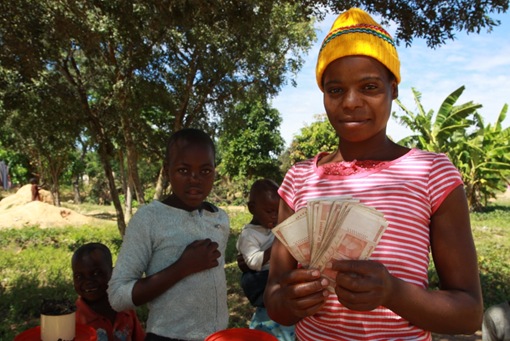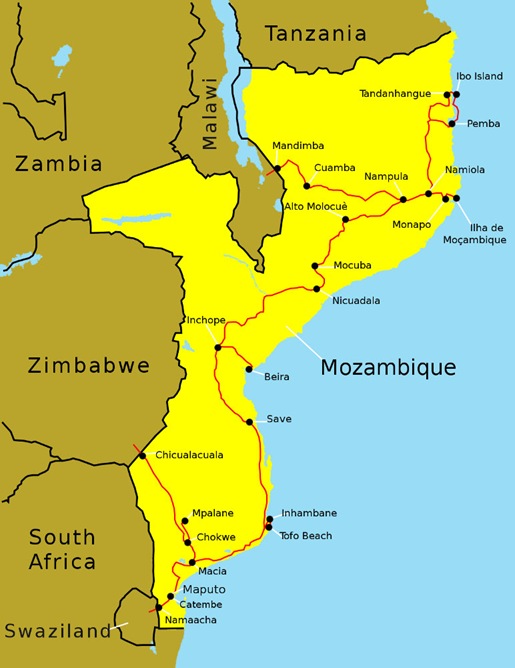Everyday bares remnants of the “crisis”. Daily reminders of how life was in Harare, in Zimbabwe, and how things can change before your eyes. It’s been only two years since the most unprecedented economic collapse of Zimbabwe’s currency plunged the country into a severe economic crisis which has since transformed it into what it is today. Just one symptom of its ongoing political instability. Only two years ago, workers pushed wheelbarrows of Zimbabwean dollars down the main streets of every major city and town in search of a few slices of bread, only to find that there was no bread to be bought. It was likened to us as an episode of Twilight Zone where people had lots of money, but nothing to buy. When payday came at the end of each month, the masses of Zimbabwe rushed to the closest supermarkets and shops to buy what they could, knowing that their money would be worth half as much if they waited just an hour or so to get in line. That’s how quick the inflation was rising. By the end of the day, their month’s wages would be value-less; not even enough to catch the bus home. And if they were at the end of the serpent-tailed line of the bank, they would be lucky to find any money left to take away as a souvenir that they’d worked hard for a month. The first to arrive in the stores were served, while those who arrived just 40 minutes later were left to search the empty shelves as one admires a museum void of artifacts (ie, with a glare of miscomprehension). The luckiest found a few loaves of bread costing an equivalent of $8 or $10 U.S. The expressions of your average Zimbabwean today become sour whenever the “crisis” is brought up. It was the moment when being Zimbabwean changed meaning.
At the same time that the absurd crash of the Zim dollar had hit its peak, Gideon Gono, on behalf of the Zimbabwean Treasury, announced that the country would now be printing notes of ten-trillion Zim dollars (10,000,000,000,000 Zim Dollars). This was supposed to lighten the load one needed to push down the road. But of course, as one expects to be the result of throwing fuel on a fire inflation, the ten-trillion bills were soon as worthless as the rest. One woman we spoke to had carried a school backpack full of grotesquely overestimated bills to the market, the total of which in the morning equaled roughly thirty US dollars, but by the time she went to buy a single tomato she had not enough for it. The basic reason for the crash is simple: the ruling party of Zimbabwe needed more money than existed in hard currency in order to implement the changes it wanted to, so it printed imaginary money. What remains unclear, is how when the majority of its citizens had lost everything, and all industries began shutting down since they could no longer pay their employees, why they didn’t stop printing fake money (and actually increasing their spending).
Today, the sides of the streets are literally littered with Zimbabwean money. Tourists delight in collecting these bills as a treasure of historical value since they have nearly no other value individually as a currency. We’ve heard of bills going for 100 times their value on Ebay. Throughout the countries markets, borders and tourist attractions, vendors sell the bills alongside curios, masks, and traditional instruments as if they too were souvenirs of a cultural experience. And what an experience indeed! Most Zimbabweans we spoke with had lit their life savings on fire, cursing the heavens with the smoke. The Zim dollar is still used, though rarely, as the official currency of the country is foreign. Both the US dollar and the South African Rands are exchanged fluently between the hands of every merchant, bus driver, store clerk and street vendor. But those who managed to save a few of their bills from the kindling pile still use them in the surrounding areas of the cities. Wads of bills pile the fruit vendors, as 12 bills of 50 billion Zim dollars will buy you two bananas. Eugénie and I tried desperately to figure out how to pay with the bills, counting the heavy zeros in amazement, when the crowds gathered around us to laugh at the absurdity of their currency. They also liked to poke fun of our inability to comprehend the complexities this can cause to a community. But every European grandmother remembers when it took a wheelbarrow of Deutschmarks to buy a loaf of bread in postwar Europe. How then does this happen in peaceful and prosperous Zimbabwe today? And moreover, how do the lives of normal people get organized amidst such confusion?
During the collapse of the Zim Dollar, expatriates, rich locals, and a few lucky others planned their weekly needs to coincide with bi-weekly road-trips crossing into South Africa or Botswana to fill their cars with cereals, rice, vegetables, bread, toilet paper, hand soaps, and all other necessities.
"The solidarity has rarely reached such heights," remarks a nostalgic wife of a diplomat. "Once a neighbor had eggs, we all raced to trade something for the first one to come out!"
Even the most reluctant “privileged” person began gardening. No, no, not for pleasure, but for survival and for a bit of illusion that nothing was abnormal as they saw food in their pantries. Employees of international enterprises enjoyed the gift of gasoline purchased by their companies abroad. Other foreigners and wealthy Zimbabweans bought "gas coupons" in Europe or South Africa, allowing them to buy from “private stocks” of fuel at the cost before the inflation. For normal people however, Zimbabweans trapped without food in a 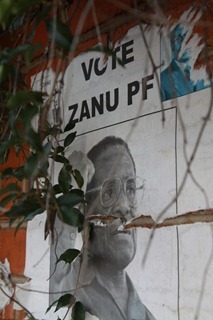 country where money is worthless, life was very different. A liter of gasoline was then U.S. $ 5 on the black market (and hard to come by). Resourcefulness, caring, trafficking, trading through solidarity, simply ignoring poverties grip; anything one could do to feed his/her family.
country where money is worthless, life was very different. A liter of gasoline was then U.S. $ 5 on the black market (and hard to come by). Resourcefulness, caring, trafficking, trading through solidarity, simply ignoring poverties grip; anything one could do to feed his/her family.
The crisis was most unfortunate for most, and quite fortunate for a few. Since the savings banks disappeared over night, so did everyone’s savings. But those with assets sat happy watching the US $ creep in. Newspapers besieged their pages with the stories of families who were just days before middle-classed families who had no choice but to push their children to the street to beg or sell themselves however they could. But the central banks locked the exchange rate of the Zim dollar at 30,000 to the US$, even as the inflation continued to spiral out of control. This meant that only ministers or other diplomatic figures could change their Zim dollars at that rate (since no bank in its right mind would do so). So ministers took as many trips abroad as they could, “to find support for this unfortunate economic situation”. Each time they presented their worthless pile of Zim dollars at the bank, they might have been awarded many thousands of US $ in exchange. Some made small fortunes. And even for the less fortunate, there was a sense of justice as major companies got hit just as hard. You might get an electricity bill at the beginning of the month for the equivalent of $300 US, and by the time you paid it at the end of the month, the amount was worth less than $1. Those who had loans to pay the banks for cars, property, business initiatives, etc., could pay them all off without a single bead of sweat forming upon their brows. This contrast of fortune through misery is what clouds the confusion of the financial collapse in Zimbabwe.
Though the economy has stabilized, the strange presence of foreign currencies still draws bewilderment and bemusement by many who visit. As an American myself, I remember being shocked by the constant flow of $2 bills being passed about the hands of every transaction (a rare specimen of bills in the US). While all five dollar bills, tens, twenty’s, ones, etc. are crisp and freshly printed before being sent to Zimbabwe, the $2’s are in a desperate state like the doilies in an elderly widows drawing room. It strikes me as likely that the US sends all their $2 to get rid of them, since they have no use in the Americas. Eugénie used American currency for the first time (and on an hourly basis) in the heart of occidental Africa. Street vendors and fruit ladies refused our bills if they looked too dirty or crumpled, though they’d tell you so with an air of arrogance since they are used to only the newest bills from most of their clientele. But really, one senses that they feared the sudden worthlessness of a currency in their grip. If one dollar can fall, so can they all. When a minibus driver has run out of rands to give back as change, he might hand you a giant wad of Zim$ 50,000,000,000’s equaling the same. Zim dollars are not refused, though banks will not trade in them, and they are worthless outside the country. Today in restaurant bathrooms sometimes still hangs a paper pleading customers “not to use Zim dollars as toilet paper, as it blocks the pipes”. Anything which is less than a dollar US should be paid in rands (ex: 10 bananas for $1 US or 1 banana for 1 SARand). One can even make a profit in Harare by paying for things with US $ and demanding their change in rands. This is because even though the official exchange rate is around 7.4 rands to the dollar, most people still consider it as a 10:1 ratio for ease of transaction. In this case, if a bus ride is 5 rand and you pay with a 1$ bill, you might get 5 rand back instead of 2. This is another reason people prefer paying in dollars.
In supermarkets the prices might be listed in either US$ or rands, or sometimes both. As in the rest of the world, they aisles tantalize false savings by marking down $2 items as $1.99. But without coins of the $, how can one expect to get their change?
- "What can I give you for $ 0.10,” asks the cashier?
- "Change?" responds the naïve customer.
- "Impossible, we have no change, but you may take two candy drops or a lollipop," says the lady behind the register.
All registers are surrounded by jars of sweets, chocolates, matches and random knick-knacks. It is better to leave with something rather than nothing for your change. Only the smartest and most obnoxiously persistent might succeed in getting some rands by way of exchange, if their change equals so much. In this context the supermarket becomes a highly intellectual sport whose aim is to match your items wisely to equal as closely to a perfect dollar as possible. At the beginning it feels a bit restrictive when shopping for groceries but becomes quite fun when you get the hang of it. Though you might have to buy something you would never normally want just to make sure you don’t lose any money in the process (like a cookie for $0.12). This is why more than any country we’ve been to, children jump up to volunteer to buy the eggs and milk for their families; to get the sweets as the change. Of course smaller supermarkets in residential neighborhoods allow your change to accumulate by writing the exact amount on your previous receipts, but in the city centers most will refuse.
So what’s the future hold for Zimbabwe’s economy, currency, legacy? Let’s see, Gideon Gono has just been reappointed for another five year term as the chief minister of finances. He is after all, despite its devastating effects on the people and businesses of Zimbabwe, the one who kept printing the money for the ruling party to do what it wanted to do. And it is the ruling party who reappointed him. Zimbabweans are by and large appalled. Years of hard work, hundreds or thousands of Zim$ saved for their dreams. But the “power sharing government” loosely established after the last scandalous elections has promised to present the country with a new constitution. A major area of dispute regarding the new constitution is who controls the printing of Zimbabwean currency. With Gono on the job, the issue has even more urgency and dispute. Of course there are those who think that the prolonged use of the $US will only improve the economy and generate a more powerful and industrious Zimbabwe than existed before the crash. The saddest part of this whole ordeal is just how ashamed Zimbabweans speak of it; like a bad dream. Every citizen knows they were the victims of a poor systems manipulation and uncontrollable greed which made them loose everything. And they know that the world all watched it on the television. But what can they do? This was the last smear on the once greatest champion of independence in Africa. During the Harare International Festival of the Arts recently, in the National Art Gallery was displayed A giant likeness of Gideon Gono formed from the useless bills of yesteryear’s currency. This was an attraction attended by thousands of viewers from a dozen nations. For some it was a symbol of the overwhelming power one man had on the nation’s economy and its failure. For others, it was the best use one could make with a pile of worthless kindling.
Above: Gideon Gono's portrait at the National Gallery of Harare / Portrait de Gideon Gono à la galerie nationale de Harare
Les ont-dits populaires rappellent quotidiennement comme Harare et la vie au Zimbabwe ont changé. Il y a à peine deux ans, en plein cœur d’une crise économique sans précédent, les supermarchés étaient vides et le $ zimbabwéen perdait de la valeur à chaque seconde. Jour de paye rimait alors avec ruée vers les magasins, il fallait faire au plus vite, au risque de voir le montant de son salaire perdre la quasi intégralité de sa valeur en quelques heures. Les premiers arrivés dans les magasins étaient les premiers servis, les autres ne trouvaient alors que des étagères vides, avec au mieux quelques miches de pain valant l’équivalent de 7 ou 8 $ US. L’inflation était alors incontrôlable. Les visages changent d’expression quand il s’agit de parler de "la crise", quand tout allait vraiment mal.
Le plus gros billet alignait alors treize zéro, 10.000.000.000.000 $. Dix trilliards, ou trillions en anglais. Un sac à dos rempli de billet servait alors à faire des commissions pour l’équivalent de 30 $ US. Aujourd’hui des milliers de $ zimbabwéens trainent sur le sol. En quelques heures mon porte monnaie s’est alourdi de 50.000.100.000$ zim ! Que les infortunés soient les bienvenus au Zimbabwe, il suffit de laisser porter son regard dans les hautes herbes, des milliers de $ s’y cachent. Milliers de $ zim qui ne valent aujourd’hui plus grand-chose. Bien que le $ US (avec le Rand sud africain) soit devenu l'unes des monnaies officielles, le $ zim est encore utilisé. Dans les quartiers lointains et populaires d’Epworth, des liasses de billets sont posées sur les avocats d’une marchande de légumes installée au bord de la route. 600.000.000.000 $ zim valent en ce moment 0.12 $ US. Il faut donc douze billets de 50.000.000.000 $ zim pour acheter deux bananes. Les vendeuses rigolent devant le client peu habitué à ce genre de calculs et l’achat d’un avocat peut ainsi prendre plusieurs longues minutes d’intense réflexion. Au Zimbabwe n’importe qui comprendrait mieux sa grand-mère, celle qui racontait l’époque d’après guerre où une brouette débordante de deutschemarks permettait d’acheter une miche de pain. Presque un siècle plus tard, ce même scénario irréaliste se reproduit, ici, au Zimbabwe.
Above: Graffiti speaks to the discontented milieu ever present in the streets of Harare following the economic crisis / Des graffitis rappellent que le mécontentement ambiant règne dans les rues de Harare
Dans ce contexte comment s’organisait la vie quotidienne des zimbabwéens ? Les plus fortunés et les expatriés profitaient de leurs week-ends en Afrique du Sud ou au Botswana pour faire des provisions. Les coffres des véhicules revenaient alors débordants de produits introuvables dans le pays. "La solidarité a rarement atteint de tels sommets" explique joyeuse mais un tantinet nostalgique la femme d’un diplomate. "Dès qu’un voisin avait des œufs c’était la course, il fallait arriver le premier !". Même les plus réticents se sont mis au jardinage. Non, non, pas pour le plaisir, pour la survie. Les salariés les plus chanceux bénéficiaient du carburant importé par leurs entreprises. Les étrangers et les nantis achetaient des "bons d’essence" en Europe ou en Afrique du Sud, ce qui leur permettait de s’approvisionner en essence à prix coûtant, le prix du précieux liquide n’était alors pas touché par l’inflation. Pour les gens normaux, les zimbabwéens pris au piège dans un pays sans nourriture où l’argent n’a plus aucune valeur, la vie a été bien différente. Un litre d’essence coûtait alors 5 $ US sur le marché noir. La débrouille, l’entraide, les trafics, la solidarité, la misère, chacun faisait alors comme il pouvait pour nourrir sa famille.
" Depuis la crise, moi, le $ zim je sers de bois pour le feu et de bloc- note pour les biens pensants. Qui aurait pu un jour me dire que j’allais servir de papier hygiénique ?! "
La crise a clairement fait beaucoup de malheureux, et quelques heureux. Les économies en banque ont disparu, du jour au lendemain. Les plans d’épargne ? Volatilisés ! Les journaux relataient alors tous des histoires plus tragiques les unes que les autres, des parents ayant économisé pour leur enfant handicapé qui n’avait alors d’autre choix que celui de mendier dans les rues, des vieillards sans le sou. Seuls les propriétaires de biens, de bijoux, de véhicules, de maison, de tout ce qui pouvait être revendu contre des $ US disposaient encore de quelques richesses. Et la banque centrale qui imprimait, imprimait et imprimait du $ zim pour tenter de donner de la valeur à cette monnaie qui ne valait déjà plus rien. Tout malheur ne venant pas sans bonheur, des situations invraisemblables ont fait des heureux. Les factures reçues en début de mois ne valaient plus rien quelques semaines plus tard, des prêts contractés auprès des banques qui soudainement n’avaient plus à être remboursés. L’économie s’est littéralement effondrée. Quelques chanceux dans ce lot de malheur. Au temps de la crise, seules les personnes pouvant voyager avaient le droit de changer du $ zim contre du $ US, le taux était plutôt alléchant, 30.000 $ zim pour 1 $ US. Par ce biais, les diplomates, les politiciens, et les business-men, les nantis ayant accès à ce taux de change se sont enrichis en changeant du $ zim contre de la vraie monnaie, le tout en prétendant vouloir porter secours à une nation agonisante.
Aujourd’hui même si la situation monétaire au Zimbabwe s’est stabilisée elle n'en demeure pas moins étrange. Gérer son porte monnaie est un coup de main à prendre. Les américains s’étonnent souvent de voir autant de coupure de 2 $, billet rarement utilisé aux USA, comme si la banque centrale américaine livrait ses billets de 2 $ au Zimbabwe pour s’en débarrasser. Au fond de l’Afrique, je paye pour la première fois de ma vie en $ US, à croire que le monde tourne à l’envers. Après avoir longuement observé votre billet de 1 $, certains vendeurs n’hésitent pas à vous le rendre avec un air dédaigneux "trop abimé, donnez m’en un autre". Ils ont simplement trop peur du fantôme d’une monnaie qui perdait de sa valeur pour la moindre raison. La paranoïa du $ règne. Le $ zim est encore aujourd’hui utilisé par ceux qui n’ont pas grand-chose d’autre. Les chauffeurs de minibus et autres petits commerçants soupirent lourdement quand un client leur tend une liasse de billet orange (ceux de 50.000.000.000 $), ils auraient évidemment préféré un billet de 1 $ US plutôt qu’une liasse de 12 billets de millions de $ zim. Mais personne ne refuse des $ zim, ceux qui les utilisent n'ont pas d’autre choix. Le Rand sud africain est utilisé pour payer tout ce qui vaut moins de 1 $ US, un paquet de biscuit ou une pile de tomates. La petite monnaie est souvent rendue en Rand car le change en $ US n’existe pas. Par exemple un trajet en minibus coûte 1 $ pour deux passagers ou 5 Rands par personne. Le passager qui tend 1 $ US recevra 5 rands de change. Au bonheur du passager qui gagne quelques rands sur chaque opération. Parce que tout est bien trop complexe, les zimbabwéens ont décidé d’aligner le taux de change du $ US sur celui du Rand Sud africain. Ainsi au Zimbabwe 1 $ vaut 10 Rands, dans tous les autres pays 1 $ vaut 7 Rands.
"Les zimbabwéens aiment parler de moi le $ zim ! Ils me distribuent à tour de bras aux étrangers passionnés par mon histoire. Un billet de 10.000.000.000.000$ zim, ça plait toujours !"
Dans les supermarchés de Harare les prix sont affichés en $ US et de temps à autre en Rand. Comme en Europe des promotions alléchantes affichent des prix tels que 1.99 $. L’idée est intéressante mais une question demeure : comment fait-on pour rendre la monnaie quand il n’y a pas de change ?
- "que puis-je vous donner pour 0,10 $", demande alors la caissière ?
- "de la monnaie ?!" répond le client naïf
- "impossible, nous n’avons pas de monnaie, mais vous pouvez prendre deux bonbons ou une sucette", annonce la dame.
Toutes les caisses sont décorées de bocaux de bonbons, de chocolats et d’autres sucreries. Il s’agit de plaire au client qui à la place de monnaie repartira avec une friandise. Seuls les plus malins et les plus persistants réussiront à obtenir quelques Rands en guise de change. Dans ce contexte faire ses courses au supermarché devient un vrai sport intellectuel, il s’agit d’avoir la facture la plus précise, au centime prêt. Au début c’est un petit peu contraignant mais cela devient amusant. Au Zimbabwe plus que nulle part ailleurs les enfants sont les premiers à se porter volontaires pour aller acheter l’œuf qui manque à l’épicerie. Quand la question "qu’est ce que tu veux pour 0,5 $ US ?" est posée, le bambin passe plusieurs minutes devant les bonbons pour choisir le meilleur.
Personne ne sait vraiment expliquer ce qui s’est passé ni comment le pays et sa monnaie en sont arrivés là. C’est arrivé, c’est ainsi. Tout le monde parle de Gidéon Gono, le gouverneur de la banque centrale qui vient d’être reconduit pour un second mandat et qui s’y connait autant en économie que George Bush en diplomatie. Il est celui qui imprimait des $ zim en fonction des besoins du gouvernement. Les zimbabwéens ne savent encore souvent pas comment réagir. Des années de travail, des centaines, des milliers de $ épargnés pour réaliser un rêve. Comme si la situation n’était pas réelle, comme si tout cet argent était encore là alors que tout le monde le sait, il a disparu. Les regards se baissent, tristes, comme si tout n’était qu’un mauvais rêve. Tous les zimbabwéens le savent, ils ont été les victimes d’un système, d’un monde politique manipulateur et incontrôlable. Que faire ? A qui réclamer cet argent ? Cette crise a touché de plein fouet l’ensemble des mortels de cette nation, sauf les hommes politiques, ceux qui ne meurent jamais vraiment. Quelqu’un a récemment enfin réussi à faire un bon usage du $ zim ! Un portrait géant de Gidéon a été exposé au cœur de la galerie d’art de Harare durant un festival international HIFA qui attirait des spectateurs du monde entier. Portrait intégralement réalisé avec un seul et unique matériau : des millions de $ zim.
"Et moi, petit $ zimbabwéen sans aucune valeur que tout le monde déteste, je traine dans les rues de Harare".

